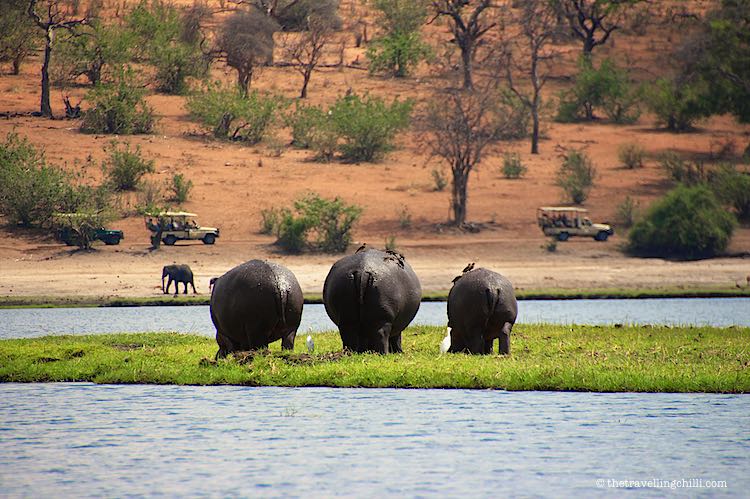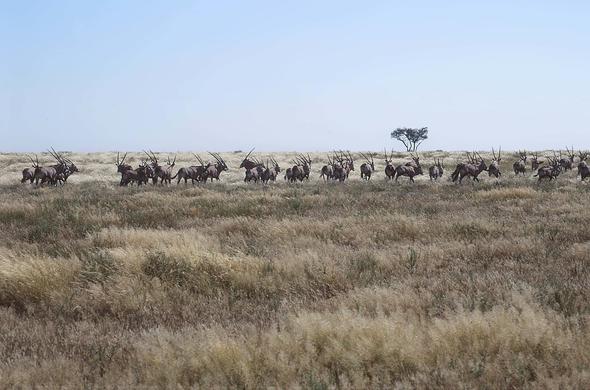Table of Contents
Top 10 Best Botswana National parks in Southern Africa
The top Best Botswana National parksl parks in Botswana are ;Chobe, Gemsbok, Makgadikgadi Pans, and Nxai Pan – are run by the Department of Wildlife and National Parks (DWNP) based in Gaborone.
Botswana is a landlocked country in southern Africa that shares a border with South Africa, Namibia, Zambia, and Zimbabwe. The country is largely defined by the vast Kalahari Desert, which covers over 70% of the landscape. The majority of the country is topographically flat. It is so flat and dry that there is no permanent standing water beyond the Okavango Delta. And its is one of the best countries in Africa to have the largest African deserts and diverse wildlife. As one of the least populated countries in the world, Botswana is has different wildlife animals from the vast Kalahari Desert to the lush Okavango Delta
The Okavango Delta lies in the northwest region of Botswana and is one of the largest inland river deltas in the world. Although not a national park, the Okavango Delta is a game reserve and is arguably one of the most beautiful in Africa with an impressive amount of wildlife.
The most popular way to explore these parks is by self-drive safaris. With a rugged four-wheel drive vehicle and decent experience camping in wilderness, most travellers will be self-sufficient camping in the bush. However, DWNP does regulate these self-safaris with strictly enforced laws against driving at night or any other time that may put travelers or wildlife in danger.
1.CHOBE NATIONAL PARK
Chobe National Park is located along the northern edge of Botswana and it is one of the most ecologically diverse parks in all of Africa, making it strategically located to view local animals in their natural habitat.
Chobe National Park is made up of four distinct ecosystems, making it one of the most ecologically diverse parks in all of Africa.
The Serondela area, or the Chobe riverfront, is located in the northeast corner of the park. The area is made up of lush marshes and woods. Much of the woodlands are made up of mahogany and teak trees, though they are receding due to the large elephant population.
To the west is the Linyanti Marsh alongside the Linyanti and Kwando rivers. Due to the waterways, this area is made up of lagoons and woodlands.
On the west bank of the park is Savuti marsh area, which is rarely an active marsh. Long ago the local water channel dried up due to tectonic plate movements in the area. Most recently, the Savuti area is covered in savannahs and rolling grasslands speckled with dead trees.
Chobe National Park is the oldest national park in Botswana. The prospect of dividing the land in Botswana to create protected areas was first discussed in 1931. The following year, the government declared tens of thousands of square kilometres as non-hunting land. Over the following decades, the area was expanded geographically with increased protection until it was declared a national park in 1967.
Despite the declaration of national park, industrial settlements remained in the area. The settlements were gradually moved out of the park and, in 1975, the park was officially protected from human activity.

WILDLIFE
The Chobe riverfront is a popular watering hole for local wildlife, especially during the dry months between May and October. Visitors can hope to spot a wide array of animals including giraffes, buffalo, antelope, many species of birds, and perhaps most excitingly, large herds of elephants.
Near the water in the Linyanti Marsh, it’s common to find hippos, herds of elephants, and crocodiles. Lions, leopards, antelope, and wild dogs roam the rest of the Linyanti Marsh region.
During the dry months, visitors of the Savuti Marsh area should look for zebras, warthogs, rhinoceros, impala and wildebeests in the area. In the wet months, lions, zebras, hyenas, and sometimes cheetahs will roam the marsh. The area is most well known as a vast migration ground for local zebras and their predators in between seasons.
To spot the large African antelopes of the savannah – elands – head to the vast dry grasslands located between the Linyanti and Savuti Marsh areas.

2.GEMSBOK NATIONAL PARK
Gemsbok National Park is located in the subcontinent of southern Africa known as the Kalahari. This desert is a vast area comprised of sand dunes. Despite the dry climate, water flows underground allowing low-lying vegetation of dwarf shrubs, succulents, and various types of grasses to grow.
Two dried riverbeds run through the desert. The Mossob and Auob rivers have been dried up for decades but are said to flow once every century to restore water to the area with flash floods. Since these floods are rare, water is pumped into the park with windmills to supply the wildlife.
As expected in the middle of the southern savannah, temperatures often reach extremes. The heat in the summer months of October to March regularly reach 40 degrees. The temperature in the winter months often drops below freezing. Record winter temperatures as low as -11 degrees have been recorded in previous years!
With mostly low-lying vegetation, the desert floor is often in direct sunlight. Fortunately, Camel-thorn trees are tall, wide-spreading trees that provide a respite from the sun for the local wildlife. A few other species of trees populate the park including shepherd trees, identifiable by their white branches, whose leaves provide nutrients and protein to local wildlife.
Due to the varying weather and deep sand dunes, it is advisable to rent a rugged four-wheel drive vehicle. High clearance on the vehicle and low range capabilities are preferable to dig out of mud pits.
The Kgalagadi Transfrontier Park straddles the border of Botswana and South Africa, with the majority of the park located in Botswana. The portion of the park in Botswana is Gemsbok National Park and the portion in South Africa is Kalahari Gemsbok National Park. However, the entire park lies in the Kalahari Desert, which also crosses into both countries.
WILDLIFE
Gemsbok National Park is named for the common herds of gemsbok, a large Oryx gazelle, in addition to other migratory herds of mammals in the area. In particular, herds of springbok, eland, red hartebeest, and blue wildebeest migrate across the immense drylands seasonally. During migration, it is easy to spot the herds on safari though they will move away quickly as you approach.
Predators are attracted to the park each season that various herds of mammals migrate across the open desert landscape. Southern African lions, cheetahs, leopards, and hyenas all live within the park borders. Unlike the herding mammals, these predators will be much harder to spot from a vehicle as they lurk in the shadows, stalking their prey.
3.MAKGADIKGADI PAN NATIONAL PARK
The Makgadikgadi Pan National Park is a salt pan located in the middle of the dry savannah. The salt pan, a desert landscape with high quantities of salt, is one of the largest in the world. However, salt pans are inhospitable environments to both plants and animals during the dry season, with only thin layers of algae surviving on the surface of the sand.
Lake Makgadikgadi left behind bright white salt plains located between Maun and Francistown. However, geologists estimate that the lake previously covered tens of thousands of square kilometres as many as 50,000 years ago. The lake likely received water the former Boteti River.
At the same time, it is likely that many other rivers also flowed over the Okavango Delta and the Chobe National Park, which are now all desert lands! The shift in water allocation was due to the shifting of tectonic plates. Overtime, the water found a new exit through Zambezi over Victoria Falls to the Indian Ocean.
Now that Makgadikgadi Pan National Park is comprised of salt pans, the rainy season is a very important time of year for the flora and fauna to flourish. From November to March, these drylands blossom into lush grass-plains and become some of the most important thriving wetlands in Botswana.
Similar to Gemsbock National Park, great herds of mammals traverse the wetlands during the rainy months during their seasonal migration. This route is part of southern Africa’s largest remaining migration – a magnificent site.
Makgadikgadi Pan National Park, located on the north-eastern side of Botswana, is a shimmering, white, endless plain stretching over 6,200 square kilometres.
WHEN TO VIST
During the dry season, life in the salt pans of Makgadikgadi Pan National Park is scarce. Hot, dry winds frequently blow over the loose sand and, with only salt water available, it is unlikely the blue-green algae of the area will find any company.
However, wet season brings out flora and fauna in the masses. Not only do herding mammals frequently migrate over the great grasslands, but the wetlands also invite migrating birds. Ducks, geese, and large white pelicans can be spotted flying overhead or taking breaks along the newly lush landscape.
One portion of the Makgadikgadi Pan also hosts one of the only two breeding populations of flamingos in southern Africa. If travelers are very lucky, it may be possible to view the flamingo migration, watching the entire landscape turn pink.
4.NXAI PAN NATIONAL PARK
In total, the national park covers just 2,650 square kilometres – far smaller than the sister park of Makgadikgadi Pan. Portions of the park are Kalahari Desert, but three important salt-pan networks spread through the area.
The pans themselves are surrounded by fossilised Kalahari dunes, providing a peek into ancient developments in the vast savannah. As the dunes fill with rainwater during the wet season, herds of mammals on migration will take advantage of the newly sprouted grass and algae in the small pools.
As these grasses grow in the inhospitable salt pans, they lose their white sheen along with their barren nature. As some of these grasses take root, the land slowly converts to grasslands with acacia trees popping up intermittently.
In the south, the park also contains the historic Baines Baobabs. These Baobab trees are over a thousand years old but still stand tall with thick trunks and spindly, small branches. They were named after Thomas Baines, the English explorer and nature-lover who painted them in 1861. Even hundreds of years later, they nearly match Baines’s painting perfectly.
The Nxai Pan National Park shares a border with the Makgadikgadi Pan National Park and also consists of almost entirely salt pans in the north-eastern region of Botswana.
WILDLIFE ANIMALS AT THE PARK
The park is situated with both herbivores and hunting predators alike. Herds of elephants, giraffes, zebras, wildebeest, springbok, impala, and ostrich migrate across the grasslands during wet season. Meanwhile, lions, leopards, cheetahs, wild dogs, jackals, hyenas, and aardwolves will follow the herds to stalk and hunt the herbivores during migration.
WHEN TO VISIT NXAI NATIONAL PARK
During wet season between November and March is the best time to visit Nxai National Park to witness the great migrations and, if you are lucky, a few predators. However, the wet season can also bring heavy rains that decrease road conditions. If ill-prepared, it can be dangerous to navigate the muddy roads during the rainy months.
Alternatively, the dry months of April to October offer nearly impeccable road conditions that even a novice could navigate. Unfortunately, dry season sees very little wildlife activity in the park due to the harsh winds, glaring sun, and lack of water for wildlife.

